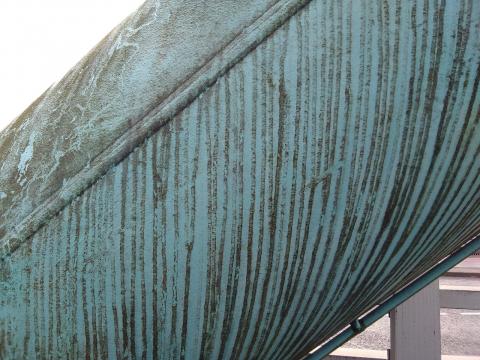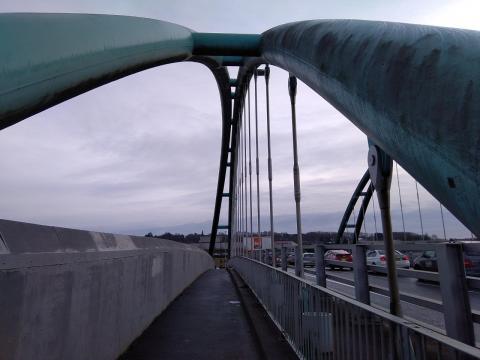Wainwright Bridge, Blackburn

Killing time in Blackburn, I wandered across to Wainwright Bridge. This connects two of the town’s busiest roads with council promises of improving traffic flow and shortening journey times. Motorists will have their own thoughts on whether these noble pledges were met. It was named after the wonderfully erudite but godless Alfred Wainwright, native of that parish, who is now better associated with the Lake District fells about which he wrote.
I have driven over the bridge many times but never have I traversed it on foot. The decaying remains of someone’s sick lay on the pavement, presumably from the previous night’s binge drinking. Empty crisp packets fluttered in the breeze and some ill-spelt graffiti bragged about its author’s levels of fertility.
The bridge is made of a single 79 metre span steel arch with a steel and concrete composite deck. The footways are carried on cantilevers and tubular twin arches are situated at each edge. I think it is pretty impressive. What did surprise me, however, was how dirty it was. Tootling past, few will espy the grimy residue which covers the otherwise bright, turquoise paintwork. Up-close, and a finger could have written in it; our virile friend could have saved himself some paint. Few will care about its cleanliness- the bridge’s function is to connect two arterial roads, not sparkle in the sun.
We Christians believe that Jesus Christ- crucified and resurrected- is our great bridge to heaven, successfully spanning the terrifying chasm of God’s awful justice. Through Him, who is the way, the truth and the life, we may again access Eden’s joy and peace. At a recent Bible Study, we considered the role of Joseph of Arimathea, whom Mark says removed Jesus’ body from the cross, wrapped it in linen and took it to his own tomb for burial. Joseph was a single-minded, as well as a good, man. The Lord’s body would have been black and blue, torn, bloodied and filthy. The clean linen in which He was carried would soon have lost its freshness as it held a broken victim of Roman justice. Likewise, the cross on which He hung was no decorated and varnished artwork, showcasing the joiner’s craft and woodman’s skill. It was rough and ready, splintered and crude. Put aside those bejewelled, golden crosses found in cathedrals and on Catholic altars. Our bridge to heaven was filthy, and not just with blood and dirt. The dying Lord was soiled by every piece of human sin; He was splashed and coated in our stinking, rebellious scum. Every adultery, murder, envious desire and proud thought was attached to Him and reckoned as His. So obnoxious and horrible did He appear that the Father could not bear to look on Him, darkening the sky and turning away His face:
You are of purer eyes than to behold evil,
And cannot look on wickedness. (Hab. 1:3)
Blackburn’s drivers care little for their bridge’s dirty state so long as it passes them from A to B, yet we Christians glory in the old, rugged cross. It is the wonderful means by which we are forgiven and go to heaven. It is the bridge over which we go to spend eternity with our Beloved, now one who is glorious in His apparel.
For I determined not to know anything among you except Jesus Christ and Him crucified. 1 Cor. 2:2


- Log in to post comments


 Sunday Worship 10.45am & 6.00pm
Sunday Worship 10.45am & 6.00pm